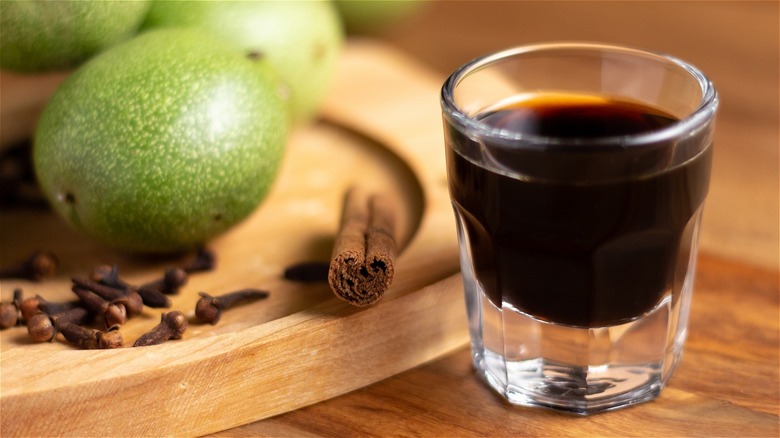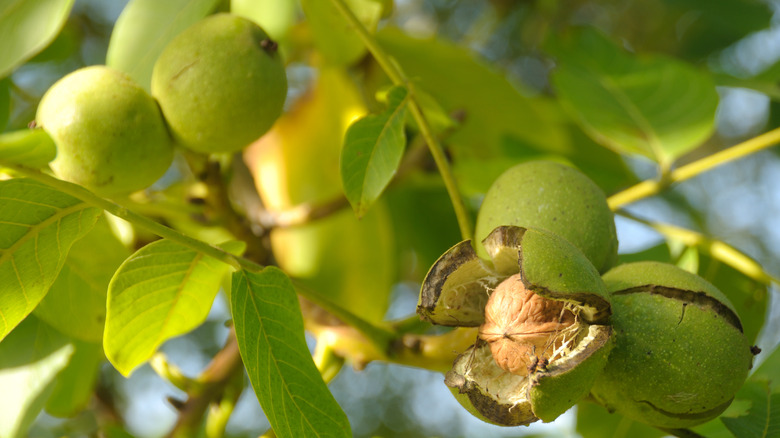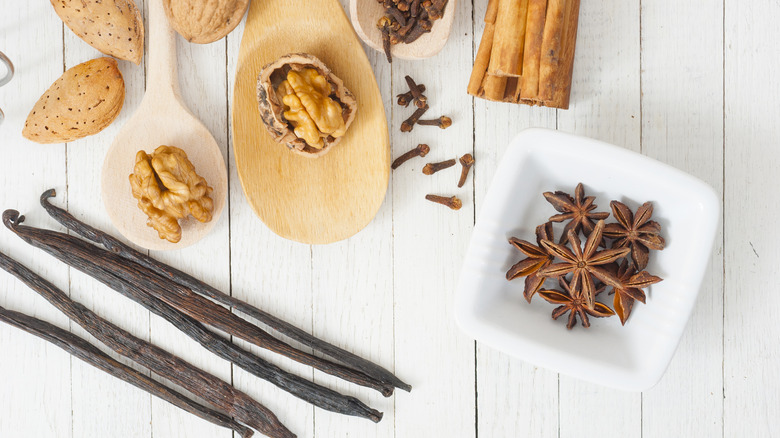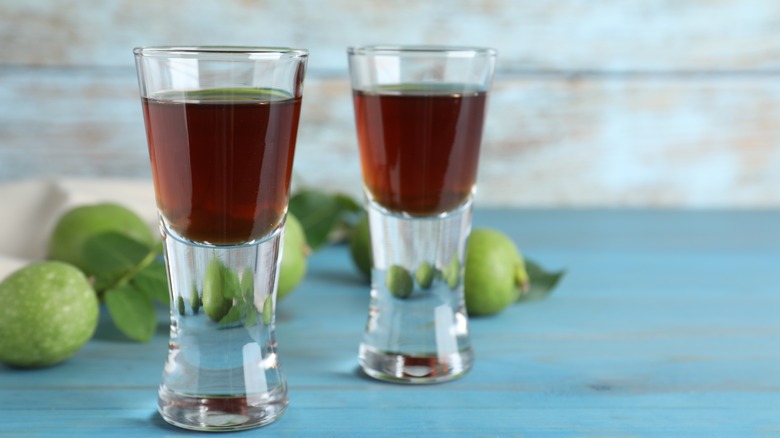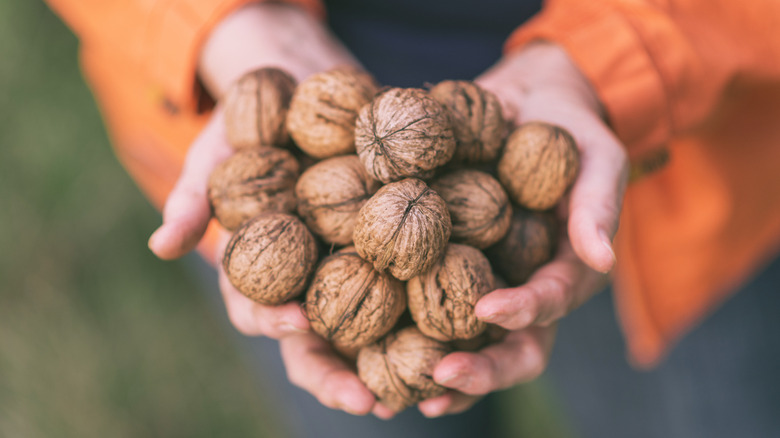What Is Nocino And How Do You Drink It?
Few have perfected the art of eating and drinking quite like the Italians. From start to finish, the Italian dining experience is complete with boozy accompaniments — like aperitifs and digestifs — that are drunk with the intention of enticing the appetite and improving digestion, respectively. Typically enjoyed after dinner, Nocino is a bittersweet liqueur made from unripe walnuts that belongs to the latter camp.
The origins of this tasty digestif are somewhat hazy, with some suggesting that walnut-flavored liqueur was introduced to Italy by the French. However, records dating back to the 13th-century point to Modena, a small city in Italy's Emilia-Romagna region, as the birthplace of Nocino. Legend has it that on June 24 — the same day as the regional celebration of St. John the Baptist, which convenes with the pagans' summer solstice – barefoot virgins would hoist themselves high into the surrounding walnut trees to retrieve the unripe fruits, which would be used for the making of this magically-infused sipper.
The production of Nocino no longer requires the employment of barefoot virgins, though makers of the drink continue to use June 24 as a marker for their short harvesting season. While walnuts are typically harvested in the fall after they've had time to ripen, Nocino is distilled from the green, unripened fruit. As such, the immature fruit is collected during the sunset of summer when the fruit is most fragrant, which lends to the drink's bitter and earthy flavor profile.
How Nocino is made?
While turning unripe walnuts into a sweet and slightly bitter booze may seem like an act of magic, in reality, it is done using a simple cold infusion process. Once the green fruits have been collected, the husks are opened to reveal a dark, gooey sap at the center that, if left on the tree long enough, would eventually ripen to form a nut. It is this liquid, however, that will act as the flavoring agent for Nocino, also providing it with its inky black color.
After being quartered, the walnut husks are covered in a neutral liquor such as vodka or grappa, often with the addition of aromatics like vanilla, clove, and citrus peels, before being left to macerate for at least three months. Once the alcohol has leached the walnuts of their soluble flavor compounds and nutrients, the husks are strained from the mixture. A combination of water and sugar is then added to dilute the intensely flavored liquid and enhance its drinkability. While there are plenty of major liquor producers in the business of making Nocino, many individuals in Northern Italy choose to make their own batches of the after-dinner drink at home.
What does Nocino taste like?
While the taste of Nocino may vary slightly from one maker to the next, the predominating flavor is always that of unripe walnuts. As such, it is subtly earthy – bordering on herbal — at first, though this is quickly followed by distinctly nutty notes. The tannins in the walnuts lend to its bitterness while the inclusion of simple syrup ties the whole ensemble together with a sweet finish. Because Nocino is crafted with the idea of letting the flavors of the walnut shine, it is typically made without an abundance of additional flavoring agents. Oftentimes, it will contain notes of vanilla, warming spices, and citrus, depending on the botanicals included during the infusion process.
Store-bought versions of Nocino have a minimum ABV of 30%, with most brands landing somewhere around the 40% range. Because there are so many at-home varieties of Nocino, the alcohol content can vary greatly, depending on the ABV of the base alcohol and the volume of water and sugar used to dilute the infusion.
How to drink Nocino
Classified as a digestif, Nocino is designed to improve digestion following a hearty meal. As such, it is most commonly served neat and at room temperature. Unlike limoncello, which is often taken as a shot, the warming flavors of Nocino encourage you to take things slow and sip on it. However, the unique flavor profile of Nocino also makes it an attractive addition to a number of classic cocktails.
Substituting Nocino for angostura bitters or sweet vermouth in an Old Fashioned or Manhattan respectively, imbues these classic libations with a rich nutty flavor that deepens their warming nature. If you're looking for something a little lighter, shaking Nocino with whiskey, egg white, and lemon can produce a bright and slightly spicier version of a classic Whiskey Sour. The bitter-sweet flavor of Nocino also pairs well with a number of coffee and dessert cocktails, and, speaking of dessert, pouring a shot of Nocino over a scoop of vanilla or chocolate gelato is the perfect way to adultify an affogato.
Where to buy Nocino
A rose by any other name would smell as sweet, and Nocino by any other name will also taste quite similar. While the traditional walnut-infused liqueur goes by Nocino in Italy, equivalent versions of the libation are crafted in a number of European countries. In France, it is recognized as Liqueur de Noix, while the Austrians and Germans call their version of green walnut liqueur Nüsse or Nüssenschnaps.
Because Nocino is still widely unknown in the United States, you're unlikely to find Nocino or one of its equivalents in your local package store. While Nocello, a lower-proof walnut-flavored liqueur, may be easier to get your hands on, scoring a bottle of real-deal Nocino may require some outsourcing. U.S.-based stores that keep Nocino in stock are typically international wine shops, specialty liquor stores, and wholesale wine stores. If you don't have any such stores in your area, many retailers with an online presence offer the option to order online and have Nocino shipped to your door with the price of a bottle ranging from $18 to $250. A number of local distilleries now manufacture small batches of Nocino, many of which also provide a shipping option.
Nutritional Information of Nocino
While Nocino is commonly enjoyed as an after-dinner treat, it has surprisingly much to offer in regard to nutrition. The liqueur actually does work as a digestive tonic, stimulating saliva production which, in turn, increases gut motility and rouses digestion. The walnuts also supply the infusion with tannins, which support the gut microbiome by promoting the growth of healthy bacteria. This can help to decrease feelings of fullness and indigestion.
More than that though, a 2021 study published in the Journal of Food Science and Technology discovered that liqueur made from green walnuts is often rich in polyphenols, a plant compound that acts similarly to antioxidants, supporting brain health and protecting the body against heart disease, diabetes, and cancer-causing free radicals. Nocino is also chock full of vitamins and minerals, such as vitamins C and E, a number of B vitamins, calcium, potassium, magnesium, and phosphorus. Nocino is also an excellent source of iodine, which supports healthy thyroid functioning and keeps fungal and bacterial infections at bay.
